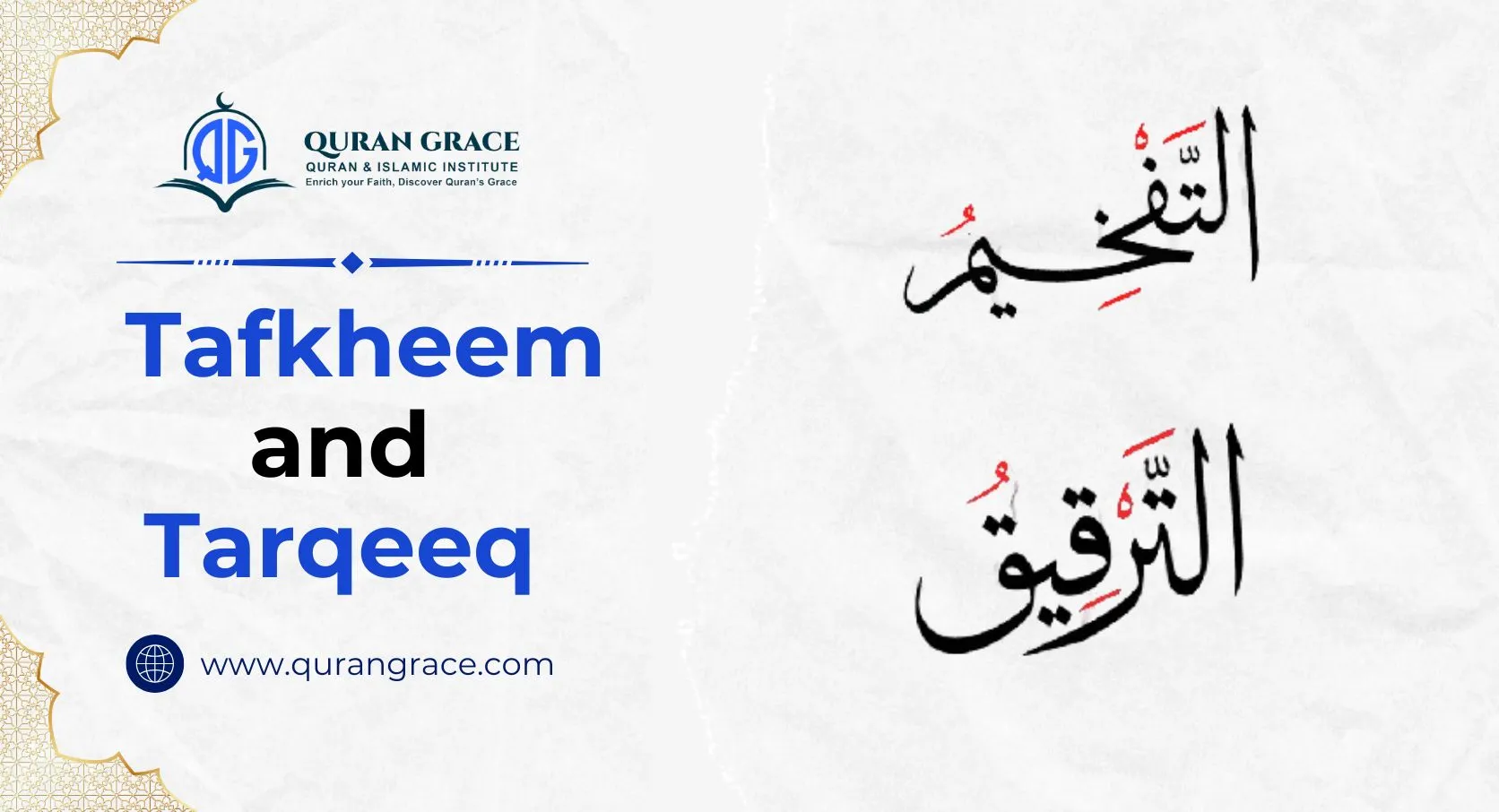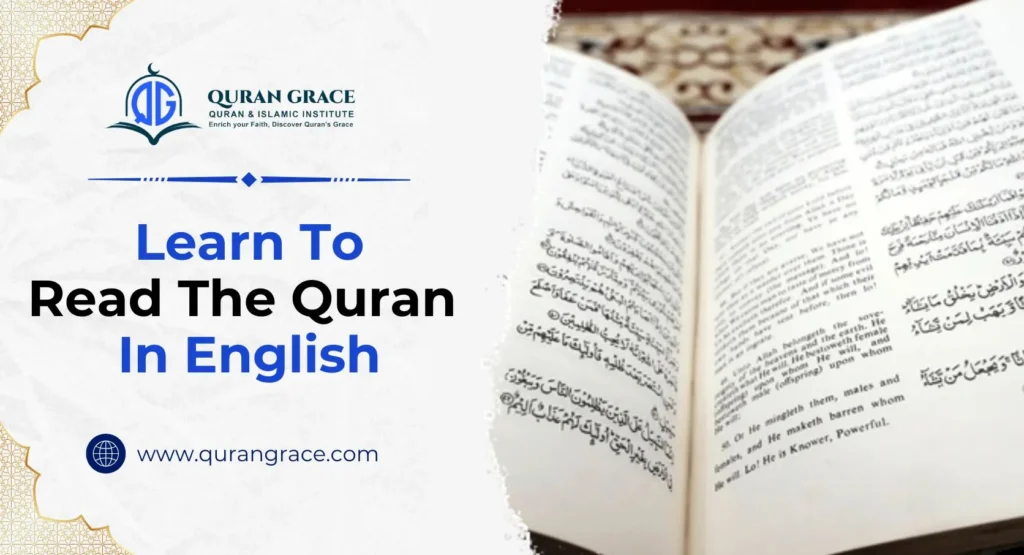Tafkheem and Tarqeeq are essential Tajweed rules that focus on the correct pronunciation of letters in the Quran. In Arabic, most letters are classified as Muraqaq (light), while a smaller group is designated as Mufakham (heavy). It’s important to note that some letters can switch between being Mufakham (heavy) and Muraqaq (light) depending on their position within a word and the accompanying Haraka (vowel marks). In this discussion, we will explore the Arabic letters categorized as heavy and light in pronunciation, using examples from the Quran to illustrate these concepts effectively.
Table of Contents
ToggleWhat is Tafkheem?
Tafkeem refers to the heaviness found in the pronunciation of Mufakham (heavy) letters, which results in a rich, resonant sound. These heavy letters are known as the letters of Isti’laa (pronounced with an elevated tongue). This elevation creates a gap between the tongue and the roof of the mouth (the soft palate), allowing for that distinct echo and resonance associated with these letters.
Tafkheem Letters With Examples
Tafkeem letters make up the minority of all letters. There are only seven letters in the Arabic alphabet. In the table below, the letters of Tafkheem, along with Quranic references, are stated.
| Letter | Example From the Quran |
| Taa (ط) | عَلَى الطَّرِيقَةِ لَأَسْقَيْنَاهُم مَّاءً غَدَقًا |
| Daad (ض) | وَأَقْرِضُوا اللَّهَ قَرْضًا حَسَنًا |
| Saad (ص) | وَيُقِيمُونَ الصَّلاةَ |
| Dhaa (ظ) | وَإِنَّ لِلَّذِينَ ظَلَمُوا |
| Qaaf (ق) | إنَّ اللَّه عَلَى كُلِّ شَيْءٍ قَدِيرٌ |
| Ghayn (غ) | غَيْرِ الْمَغْضُوبِ عَلَيْهِمْ |
| Khaa (خ) | خَالِدِينَ فِيهَا أُوْلَئِكَ هُمْ شَرُّ الْبَرِيَّةِ |
5 levels of Tafkheem (heaviness of letters)
The concept of Tafkheem in the Quran is characterized by five distinct levels, each with subtle differences in pronunciation:
- Heavy Letter with Fatha and Lengthened Alif: This involves a heavy letter accompanied by a Fatha (a short vowel sound) followed by an elongated Alif (referred to as Alif Madda).
- Heavy Letter with Fatha: In this case, a heavy letter is simply paired with a Fatha without the lengthened Alif.
- Heavy Letter with Damma: This level features a heavy letter followed by a Damma (another short vowel sound).
- Heavy Letter with Kasra: Here, the heavy letter is followed by a kasra, which indicates a different vowel sound.
- Heavy Letter with Sukoon: The final level is characterized by a heavy letter that ends with Sukoon, indicating the absence of any vowel.
Understanding these levels of Tafkheem enhances your Tajweed skills and makes your recitation strong.
What is Tarqeeq?
Tarqeeq refers to the process of thinning in the body of Muraqqaq, or light letters, characterized by a lack of echo or reverberation in pronunciation. These light letters are also known as the letters of ‘Istifal,’ which translates to ‘falling down.’ This concept stands in contrast to the Istila letters discussed in Tafkheem, as Istifal letters allow the tongue to rest at the bottom of the mouth, with no echo present.
Tarqeeq Letters in Arabic
Tarqeeq letters make up the vast majority of the Arabic alphabet. It is easier to consider that they are all the letters except the letters of Tafkheem (ط – ض – ص – ظ – غ – خ) and the letters that could be light or heavy (ر – ل – ا).
Letters That Could Be Heavy or Light:
In Arabic phonetics, certain letters exhibit characteristics of both Tafkheem (heavy pronunciation) and Tarqeeq (lighter pronunciation). The distinction depends on various elements, including the Haraka (vowel marking) of the letter as well as the letters that precede or follow it. The letters that demonstrate these dual properties include
- – ر (Raa)
- – ل (Laam)
- – ا (Alif Madda)
Additionally, the Ghunna (nasalization) is also affected by these rules. If you’re interested in deepening your Tajweed understanding for accurate Quran recitation, consider joining the exclusive advanced tajweed course by Quran Grace. Where you will learn all these important quran tajweed rules in great detail.
Tarqeeq Letters With Examples
- مَكَة (Makkah): The letters م (Meem) and ك (Kaaf) are pronounced with Tarqeeq, giving them a light sound.
- نُور (Noor): The letters ن (Noon) and و (Waw) are pronounced with Tarqeeq, making them sound light.
- سَمَاء (Samaa): The letters س (Seen) and م (Meem) are pronounced with Tarqeeq, adding a light quality to them.
- رِياح (Riyaah): In this word, the letter ر (Raa) is pronounced with Tarqeeq because it has a kasra (ـِ).
- زَرَع (Zara’): Here, the letter ر (Raa) is pronounced with Tarqeeq because it is surrounded by Tarqeeq letters (ز and ع).
- فِكْر (Fikr): The letters ف (Faa) and ك (Kaaf) are pronounced with Tarqeeq, making them sound light.
- شِفَاء (Shifaa): The letters ش (Sheen) and ف (Faa) are pronounced with Tarqeeq, giving them a light sound.
- بِسْمِ (Bismi): The letters ب (Ba) and س (Seen) are pronounced with Tarqeeq, making them sound light.
- تَفَاح (Tafaah): The letters ت (Ta) and ف (Faa) are pronounced with Tarqeeq, adding a light quality to them.
The letter Raa (ر) in Tafkheem and Tarqeeq
In Tajweed and Quranic recitation, the letter “ر” (Raa) can be pronounced with either Tafkheem (heavy) or Tarqeeq (light), depending on the surrounding letters and the presence of certain vowels. Here are some examples to illustrate:
Tafkheem of Raa (ر):
Tafkheem refers to a specific pronunciation rule in Arabic when the letter ر (Raa) is articulated with a heavier sound. This phenomenon occurs when the Raa is accompanied by a fatha (ـَ), damma (ـُ), or shadda (ـّ), and it is either preceded or followed by one of the Tafkheem letters, which include ص, ض, ط, ظ, ق, غ, and خ.
For example, in the word رَقَد (Raqad), the Raa is pronounced heavily because it is followed by the Tafkheem letter ق (Qaaf). Similarly, in the word أَرْض (Ardh), the Raa is again pronounced with heaviness due to its following letter, ذ (Dhaad), which is also a Tafkheem letter. Lastly, in the word قُرْآن (Qur’an), the Raa takes on a heavier pronunciation as it is preceded by the Tafkheem letter ق (Qaaf). This interaction between Raa and Tafkheem letters is essential for correct Arabic pronunciation.
Tarqeq of Raa (ر):
Tarqeeq occurs when the Raa is accompanied by a kasra (ـِ) or is surrounded by Tarqeeq letters.
- رِياح (Riyaah): Here, Raa is light because it has a kasra.
- مَرَر (Marar): In this word, Raa is light because it is not surrounded by any Tafkheem letters.
- زَرَع (Zara’): Here, Raa is light because it is surrounded by Tarqeeq letters.
Conclusion
It takes a little time and regular practice to pronounce the heavy and light letters while reciting the Quran. You can recite verses daily to see how well you pronounce these letters, or join an online tajweed course at Quran Grace with a free consultation and evaluation. Let’s embark on this enlightening journey to learn to recite the Quran beautifully.








